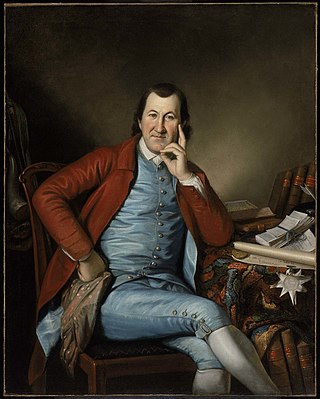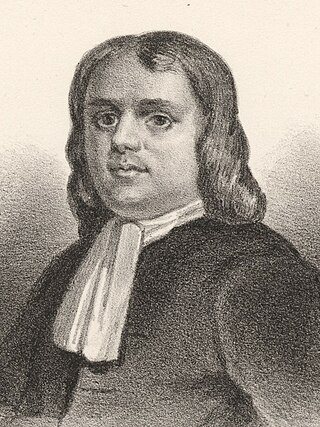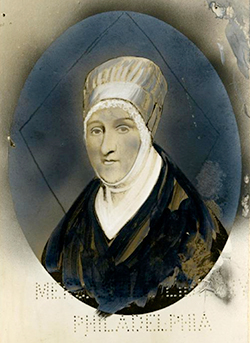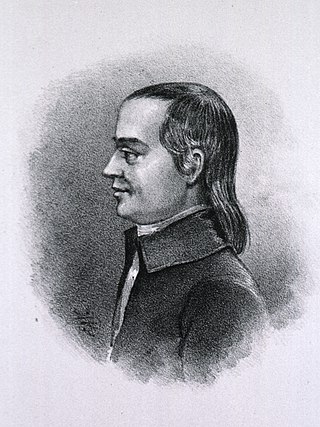
Benjamin Chew was an American lawyer and judge who served as the chief justice of the Supreme Court of the Province of Pennsylvania and later the Commonwealth of Pennsylvania. Born into a Quaker family, Chew was known for precision and brevity in his legal arguments and his excellent memory, judgment, and knowledge of statutory law. His primary allegiance was to the supremacy of law and the constitution.

The Middle Colonies were a subset of the Thirteen Colonies in British America, located between the New England Colonies and the Southern Colonies. Along with the Chesapeake Colonies, this area now roughly makes up the Mid-Atlantic states.

The Province of Pennsylvania, also known as the Pennsylvania Colony, was a British North American colony founded by William Penn, who received the land through a grant from Charles II of England in 1681. The name Pennsylvania was derived from "Penn's Woods", referring to William Penn's father Admiral Sir William Penn.

John Dickinson, a Founding Father of the United States, was an attorney and politician from Philadelphia, Pennsylvania, and Wilmington, Delaware. Dickinson was known as the "Penman of the Revolution" for his twelve Letters from a Farmer in Pennsylvania, published individually in 1767 and 1768, and he also wrote "The Liberty Song" in 1768.

Andrew Hamilton was a Scottish lawyer in the Thirteen Colonies who settled in Philadelphia. He was best known for his legal victory on behalf of the printer and newspaper publisher John Peter Zenger. His involvement with the 1735 decision in New York helped to establish that truth is a defense to an accusation of libel. His eloquent defense concluded with saying that the press has "a liberty both of exposing and opposing tyrannical power by speaking and writing truth."
Coverture was a legal doctrine in English common law originating from the French word couverture, meaning "covering", in which a married woman's legal existence was considered to be merged with that of her husband. Upon marriage, she had no independent legal existence of her own, in keeping with society's expectation that her husband was to provide for and protect her. Under coverture a woman became a feme covert, whose legal rights and obligations were mostly subsumed by those of her husband. An unmarried woman, or feme sole, retained the right to own property and make contracts in her own name.

Timothy Matlack was an American politician, military officer and businessman who was chosen in 1776 to inscribe the original United States Declaration of Independence on vellum. A brewer and beer bottler who emerged as a popular and powerful leader in the American Revolutionary War, Matlack served as Secretary of Pennsylvania during the conflict and a delegate to the Second Continental Congress in Philadelphia in 1780. Matlack was known for his excellent penmanship, and his handwritten copy of the Declaration is on public display in the Rotunda of the Charters of Freedom at the National Archives Building in Washington, D.C.

Pennsylvania was the site of many key events associated with the American Revolution and American Revolutionary War. The city of Philadelphia, then capital of the Thirteen Colonies and the largest city in the colonies, was a gathering place for the Founding Fathers who discussed, debated, developed, and ultimately implemented many of the acts, including signing the Declaration of Independence, that inspired and launched the revolution and the quest for independence from the British Empire.

Thomas Wynne was personal physician of William Penn and one of the original settlers of Philadelphia in the Province of Pennsylvania. Born in Ysceifiog, Wales, where his family dated back seventeen generations to Owain Gwynedd, he accompanied Penn on his original journey to America on the ship Welcome.

Isaac Norris was a merchant and statesman in the colonial-era Province of Pennsylvania, in British America.

1776 is a 1972 American historical musical drama film directed by Peter H. Hunt and written by Peter Stone, based on his book for the 1969 Broadway musical of the same name, with music and lyrics by Sherman Edwards. Set in Philadelphia in the summer of 1776, it is a fictionalized account of the events leading up to the signing of the Declaration of Independence. The film stars William Daniels, Howard da Silva, Donald Madden, John Cullum, Ken Howard and Blythe Danner.

Elizabeth Graeme Fergusson, or Betsy Graeme; was an American poet and writer, known for The Dream (1768). She held literary salon gatherings called "attic evenings", based upon French salons. Her attendees included Jacob Duché, Francis Hopkinson, Benjamin Rush, and her niece, Anna Young Smith. She wrote poetry and a wide range of works, taught writing, and mentored women writers, like Annis Boudinot Stockton and Hannah Griffitts.
The Eyre family refers to the descendants of George Eyre and Mary Smith Eyre who comprised a political and business dynasty prominent in the Northeastern United States from the colonial era to the early 20th century. During the American Revolutionary War several members of the family served in key military and political positions, while the Eyre shipping company proved critical in the founding of the U.S. Navy.
Hannah Griffitts (1727–1817) was an 18th-century American poet and Quaker who championed the resistance of American colonists to Britain during the run-up to the American Revolution.
Susanna Wright was an 18th-century colonial English American poet, pundit, botanist, business owner, and legal scholar who was influential in the political economy of the Province of Pennsylvania, one of the Thirteen Colonies that ultimately engaged in the American Revolution and founded the United States.

Deborah Norris Logan was an American Quaker historian and memoirist, and wife of politician George Logan.

Milcah Martha Moore (1740–1829) was an 18th-century American Quaker poet, the creator of a manuscript commonplace book featuring the work of women writers of her circle and compiler of a printed book of prose and poetry.

Margaret Hill Morris was a Colonial American Quaker medical practitioner and diarist. Her journal provides a first hand account of events of the American Revolutionary War in and around Burlington, New Jersey, including the 1776 Battle of Trenton.
The Proprietary Party, also known as the Gentleman's Party, was a political party in the Pennsylvania Colony, primarily concerned with Anglicanism and supporting the rights of the colonies hereditary proprietors, the Penns. They were typically in opposition to the Quaker Party, which sometimes resulted in violence.

Samuel Powel Griffitts was an American physician, widely regarded as the founder, in 1786, of the Philadelphia Dispensary. He was an early member of the American Philosophical Society, elected in 1785.















